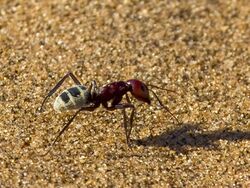Biology:Namib Desert dune ant
| Namib Desert dune ant | |
|---|---|

| |
| Camponotus detritus, Namib-Naukluft National Park | |
| Scientific classification | |
| Domain: | Eukaryota |
| Kingdom: | Animalia |
| Phylum: | Arthropoda |
| Class: | Insecta |
| Order: | Hymenoptera |
| Family: | Formicidae |
| Subfamily: | Formicinae |
| Genus: | Camponotus |
| Species: | C. detritus
|
| Binomial name | |
| Camponotus detritus Emery, 1886[1]
| |
The Namib Desert dune ant (Camponotus detritus), is a large ant species distinguished by white and black symmetrical stripes and markings on its hairy abdomen. It has an average mass of 45 milligrams (0.0016 oz).[2] It is classified within the carpenter ant genus, a large group of more than 1,000 known species, many of which are associated with forested habitats in America and elsewhere. However C. detritus inhabits the hot dry dunes of the hyper-arid central Namib Desert in Southern Africa. Like many other ant species, it obtains its food and moisture by climbing the stalks of plants and drinking honeydew from scale insects, which themselves feed on shrubs and other perennial plants. It will also feed on dead insects. The nests of this species, located amongst perennial plant roots, are systems of tunnels and chambers between 100–400 millimetres (3.9–15.7 in) deep. Nests can reach temperatures of 35 °C (95 °F) in summer, though they are much cooler in winter, typically 20–23 °C (68–73 °F). Nests are often lined with detritus - hence the binomial Latin name of the species. Each colony contains a single queen.[3]
C. detritus is a diurnal species which uses its long legs to move at 5 mm above the surface, thus avoiding the highest temperatures which at noon in midsummer can reach 60 °C (140 °F). The temperature at 5 mm may be as much as 15 °C (27 °F) below that of the surface.[3]
The buckspoor spider Seothyra has been observed preying on these ants by hiding in the sand and grasping one limb of a passing ant, pinning it to the baking surface until it cooks to death, and then dragging it beneath the surface.[4] detritus inhabits the hot dry dunes of the hyper-arid central Namib Desert in Southern Africa. Like many other ant species, it obtains its food and moisture by climbing the stalks of plants and drinking honeydew from scale insects, which themselves feed on shrubs and other perennial plants.[5]
References
- ↑ "Camponotus detritus". Catalogue of Life: ITIS. http://www.catalogueoflife.org/col/details/species/id/dffb4440598ee6a6abf9dadb4ada44da. Retrieved 2016-01-30.
- ↑ John R.B. Lighton. "Slow discontinuous ventilation in the Namib Dune-sea ant". Journal of Experimental Biology. http://jeb.biologists.org/content/jexbio/151/1/71.full.pdf. Retrieved 2016-01-30.
- ↑ 3.0 3.1 Curtis, B.A. (2015). "Activity of the Namib Desert dune ant, Camponotus detritus". South African Journal of Zoology 20 (2): 41–48. doi:10.1080/02541858.1985.11447912.
- ↑ "Spoor spider uses hot desert sand to kill captured dune ants". BBC/Science, Space and Robots. http://www.sciencespacerobots.com/video-spoor-spider-uses-hot-desert-sand-to-kill-51120142.
- ↑ "Namib Desert dune ant latest information - Google Search". https://www.google.com/search?q=Namib+Desert+dune+ant+latest+information&oq=Namib+Desert+dune+ant+latest+information&aqs=chrome..69i57j33i10i160l2.20578j0j9&sourceid=chrome&ie=UTF-8.
Wikidata ☰ Q12860349 entry
 |

